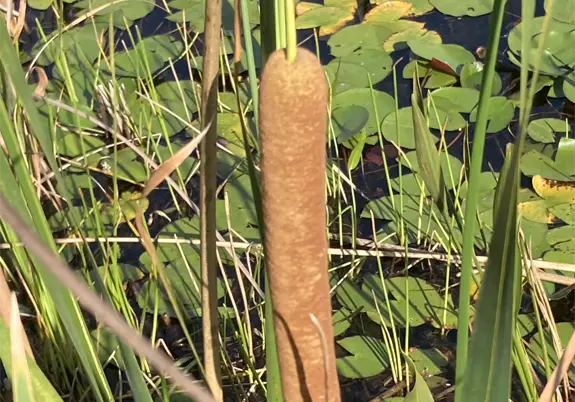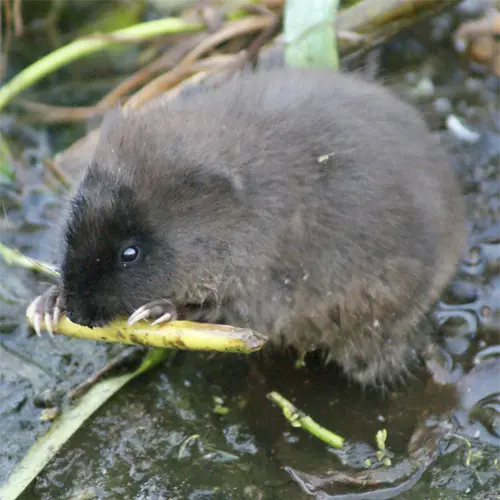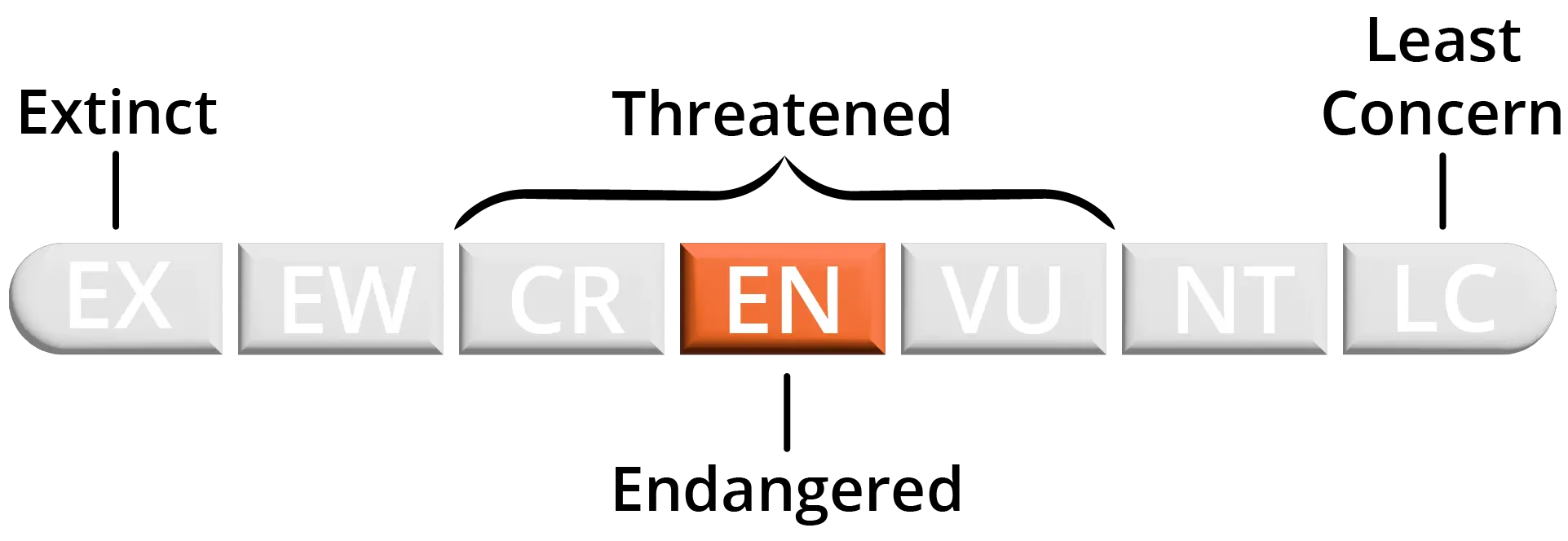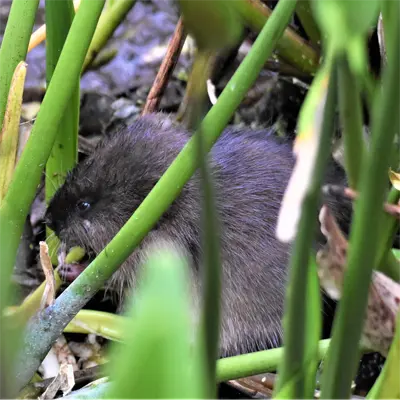Round-tailed Muskrat
- Scientific Name
- Neofiber alleni
- Also Known As
- Florida Water Rat
- Range
- Most of Florida, Except Panhandle
- Diet
- Aquatic Plants and Mollusks
- Life Expectancy
- 1 - 2 Years
Quick Links
Round-tailed Muskrat (Florida Water Rat) in Central Florida
The Florida water rat (Neofiber alleni) is a semiaquatic rodent endemic to central and southern Florida.
Often confused with introduced rodents like the roof rat (Rattus rattus) and Norway rat (Rattus norvegicus), the Florida water rat is distinguished by its smaller size, adaptations for swimming, and preference for wetland habitats.
This comprehensive guide provides detailed identification tips, biology facts, habitat information, diet, health risks, signs of infestation, and professional control methods for Florida water rats in central Florida.
Appearance and Identification
The Round-tailed Muskrat (Florida Water Rat) can be identified by the following key physical characteristics at different life stages
Adult Florida Water Rat
Juvenile Florida Water Rat
Maturation Rate
Young Florida water rats develop and mature very quickly compared to many other rodents. They open their eyes by about 2 weeks old and are weaned by 20 days of age. Florida water rats reach adult size by 6 weeks old. Females begin breeding as early as just 6 weeks of age. Their rapid growth allows populations to quickly rebound after setbacks.
Habits and Behavior
Florida water rats are primarily nocturnal and crepuscular, most active around dawn and dusk. They construct extensive burrow systems with entrance holes measuring 2-3 inches (5-8 cm) in diameter in the banks of ponds, lakes, marshes, swamps, canals, and other waterways.
Their home range is relatively small, often less than 300 square feet (30 square meters). Florida water rats are solitary and territorial animals, with both sexes defending distinct home ranges. They are powerful swimmers and divers, foraging underwater for up to 15 minutes.
Florida water rats can run on land but are slow and awkward moving out of water.
Reproduction and Lifespan
The breeding season for Florida water rats runs from March to November, with peak breeding in April and May. Females can have 1-2 litters per year of 1-6 young. Gestation lasts around 27 days. Young Florida water rats grow rapidly, reaching adult size by 6 weeks old. They are sexually mature and begin breeding as early as 6 weeks of age. Typical lifespan in the wild is 1-2 years.
Ideal Habitat and Range
The warm, humid subtropical climate of central Florida provides ideal year-round habitat for Florida water rats. They thrive in freshwater wetlands, ponds, lakes, slow-moving streams and rivers, canals, stormwater retention basins, and other aquatic environments with abundant vegetation.
Emergent marsh plants like bulrushes, cattails, pickerelweed, arrowhead, and coastal maidencane grow densely along shorelines, providing food and shelter. Flooded swamps and riparian woodlands also harbor Florida water rat populations. Even small ponds, irrigation ditches, and canals in urban areas allow them to flourish.
The combination of warm weather, abundant water, and dense shoreline vegetation allows Florida water rats to thrive across central Florida’s diverse aquatic ecosystems.
Diet and Feeding
Florida water rats are herbivorous, feeding on a variety of aquatic plants. Favored foods include bulrushes, cattails, pickerelweed, arrowhead, lilies, smartweed, and other emergent vegetation.
They also eat algae, roots, and tender young shoots. Aquatic invertebrates like freshwater mussels, snails, and insects supplement their diet, especially in winter when vegetation is scarce.
Florida water rats forage at night, swimming and diving to feeding areas. They construct feeding platforms of cut vegetation near their burrows to access food while remaining near shelter.


Common Health Risks
Florida water rats pose very low risk to human health and safety. They are not aggressive and will flee from humans when possible.
Their sharp teeth can break skin if handled, posing a minor risk of rat bite fever. Florida water rats can transmit leptospirosis through infected urine but transmission to humans is extremely rare.
Mainly, Florida water rats cause damage to waterfront structures and landscaping through burrowing activity rather than health hazards.
Signs of Florida Water Rat Infestation
The main signs of Florida water rat activity around docks, irrigation systems, boats, and other waterfront property include
Preventing Florida Water Rat Infestation
The key to preventing Florida water rat damage is exclusion – sealing off access to structures near or in the water.
Trim back thick shoreline vegetation at least 3 feet (1 meter) from docks, boats, irrigation pumps, and other waterfront installations. Search for burrow openings and seal with gravel, cement, or hardware cloth.
Surround vulnerable systems with a footer barrier of galvanized mesh fencing with the bottom edge buried 6-12 inches (15-30 cm) deep in the ground to prevent burrowing.
Trapping and removal or rodenticides may also be warranted in some cases but exclusion is the most effective long-term solution.
Population Control Methods
If exclusion alone is insufficient to prevent Florida water rat damage, lethal control using traps or rodenticides may be considered. Traps such as snap traps, cage traps, or body-grip traps can humanely capture rats for relocation or euthanasia. Glue boards are another trapping option.
Poison baits are also effective but must be used cautiously around waterways. Zinc phosphide baits are commonly used though anticoagulant baits are safer for wildlife. Control is most effective when animals are active in spring through fall – winter trapping is less productive.
Always follow label directions carefully when utilizing any rodenticides.
Florida Water Rats in Central Florida – Conclusion
The Florida water rat is a unique native species important to wetland ecosystems across central Florida. But water rat burrowing and feeding can damage waterfront structures, boats, irrigation, and landscaping if infestations go unchecked.
By properly excluding rats through vegetation control, sealing burrows, and footer barriers, most problems can be prevented in an ecologically sound manner. Some situations may require trapping or rodenticides for additional population reduction but exclusion is the foundation.
With proactive management focused on denying access, costly damage from Florida water rats can be avoided while still preserving this keystone wetland species.






